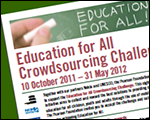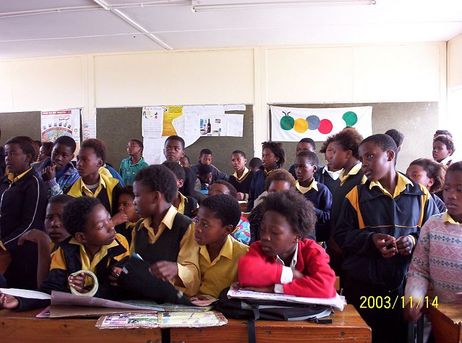Crowdsourcing the Education Needs of the World
Published Aug-12-13Breakthrough:
Tapping into the crowd’s wisdom, imagination, and knowledge to help provide quality education to all, regardless of their social background.
Company:
Education for All, France
The Story:
 In 2012 UNESCO teamed up with mobile phone company Nokia and nonprofit organization Pearson Foundation to launch the eight month long 'Education for All (EFA) Crowdsourcing Challenge'.
In 2012 UNESCO teamed up with mobile phone company Nokia and nonprofit organization Pearson Foundation to launch the eight month long 'Education for All (EFA) Crowdsourcing Challenge'.The aim was to get some fresh ideas and new thinking on how mobile communications can help EFA achieve its goals. Those goals include developing universal primary education, addressing youth and adult learning needs, and achieving gender parity and equality in education.
In EFA’s words, there is an educational crisis in developing and some developed countries. The problems are many and varied. For example, some countries don’t have, and may never have the financial resources to provide quality training for teachers, and send them to every school.
So the search was on to see what possibilities mobile technologies could provide. “The answer is out there,” said Steven Vosloo, Programme Specialist in Mobile Learning at UNESCO. “But how do we harness the collective intelligence to try and get those answers out?”
New Approaches Needed
The target for EFA's goals to be met -as laid down by the World Education Forum in Dakar - is 2015. The expectation is that they cannot be met by following traditional, tried and test ways of innovating.
“We will not be able to deliver on the Education For All goals without the active participation of the very people who are affected by the lack of access to education,” said Shafika Isaacs, Consultant on Technical Vocational Skills Development at Commonwealth of Learning.
Each month, the competition focused on a different challenge and prizes were awarded for the best ideas. Participants included education experts, teachers, students, and software developers and they were encouraged to interact with each other and riff on ideas. Once presented, the concepts were voted on and discussed by members the challenge community.
Breakthrough Ideas
Almost 1,000 ideas were presented during the course of the challenge and six winners were selected and awarded prizes of $3,000 each. They were chosen by an international panel of judges.
The winning ideas were:
• I-Learn by Swaroop John (Switzerland) – the application encourages
picture-based learning to complement radio broadcasts.
• Mobile Partners in Education by Laura Blackheart (United States) – this
application partners girls in disadvantaged communities with an advantaged
classroom using mobile technology.
• Health Phone by Nand Wadhwani (China) – videos, audio recordings, text
and images will be delivered via mobile phones to women to help them
make healthy decisions for themselves and their families. The content will
include information on nutrition, infectious diseases, pregnancy, and
childbirth.
• Test On Texts by Sanjith Yeruva (India) - a mobile application that helps
students assess their knowledge and suggests content in an intuitive
manner.
• Education Time Bank by Eric Kotonya (Kenya) – an app for teens and adults
to learn personalized, interactive short sessions on specialized topics.
• Start "Mission for the week" programme by Harkirat Singh (India) – a mobile
app that gives teachers a new mission every week that will help students
achieve the best results.
Future Direction
Full details of the winning ideas have been published on the UNESCO website to encourage further discussion and help turn the proposals into concrete, life-changing ideas.
Next Story »Article by: Paul Arnold

